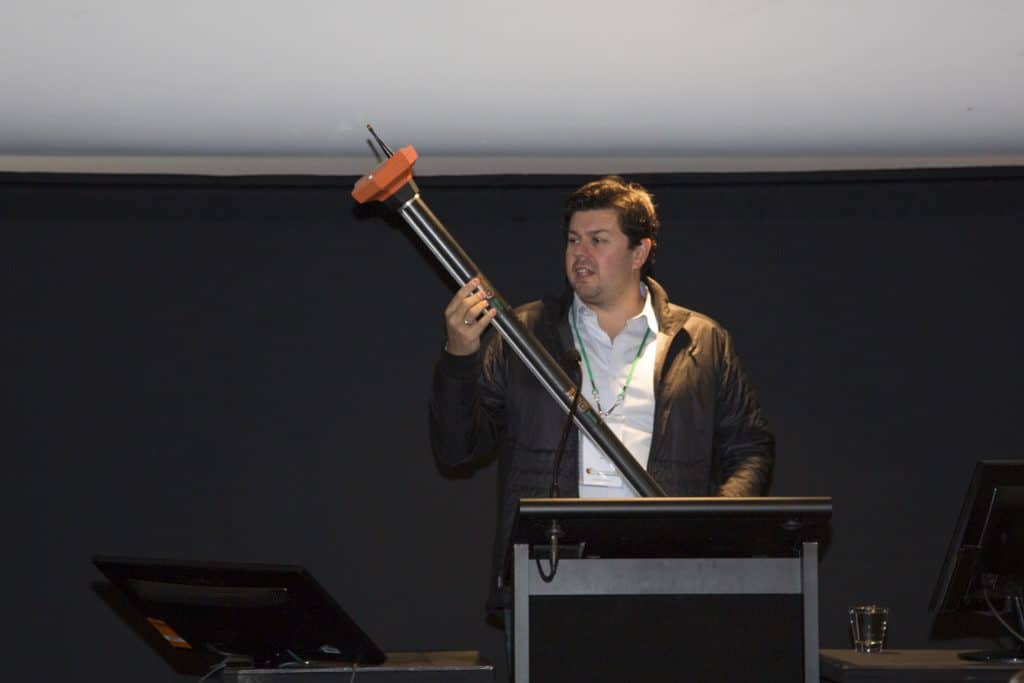By Heather Chalmers
New Zealand is one of the first countries to adopt United States-designed wireless NPK soil sensors, prompting a visit by its Wall Street developer.
The Teralytic soil probes are being trialled in New Zealand’s potato growing regions, with 120 arriving in September. This follows a smaller-scale trial last season.
Teralytic founder and chief executive Steve Ridder is based at its head office on Wall Street, opposite Trump Tower.
Speaking at the Potatoes NZ Inc conference in Christchurch in August, he said the agtech firm started three years ago to provide real-time information about what was happening in the soil.
Traditionally, soil testing is a manual and time intensive process that can take days or weeks.
In contrast, the probes provide ongoing data before and while a crop is being grown, optimising on-farm management as well as providing aggregated data for environmental compliance. “So growers know what is happening beneath the ground and can make real-time decisions.”
The probes, which stand about 1.2 metres tall are simple to install and get started. “Just put the probe in the ground and turn it on.”
Probes wirelessly send a range of surface, soil and air quality measurements back to growers, including nitrogen, phosphate and potassium levels, soil moisture, soil temperature and humidity readings, as well as pH levels.
Each probe, built to remain in the field all season, has a total of 26 sensors placed at depths of 15cm, 45cm and 90cm.
“The first two depths are for on-farm management, while the lowest depth is for compliance, such as measuring any leaching.”
Probes take a sample reading every 15 minutes, sending the information wirelessly to cloud servers where it is analysed. Farmers receive real-time and predictive information to help in decision making.
Growers pay a subscription of US$500 a sensor a year, with about two a paddock recommended.
“Unlike most US companies in the online space, we don’t own the data.”
Steve Ridder said that while up to 50 per cent of farmers’ operating costs go on fertiliser, up to 50 per cent of this could be washed away into rivers and streams or converted to a greenhouse gas.
In its first two years, Teralytic worked to match the probe readings with those of a standard soil laboratory report.
“What we are looking for are the ions and nutrients that are available to the plant in the soil.
“At any time in the season a grower should be able to take a sample and send it to a lab and get a similar result to the probe reading.
“We are starting to do a lot of modelling to enhance decision-making, so growers can be proactive in getting ahead of nutrient deficiency problems.
“Then you don’t have to wait until the plant tells you it is not happy, so farmers can be preventative and active rather than reactive.”
This provided an ongoing picture of a paddock’s nutrient status, rather than the “snapshot” farmers obtained once a year or less through soil testing or crop yield mapping, that was used to determine variable rate applications.
“The probes build a picture by the hour, day and month. You can see how nutrients in a paddock change over time, rather than just one snapshot a year.”
Consumers also wanted more transparency and were not just looking at the nutrient levels of food, but whether “the healthy food was grown in a healthy environment”.
This compared with the more typical anecdotal approach of growers talking about their sustainability programme, with no way to link back to the actual crop and how much water and fertiliser was used, Steve Ridder said.
Teralytic could also import data from other platforms, such as yield maps.
Potatoes NZ chief executive Chris Claridge said that of the 120 probes being trialled, 60 would go to Plant and Food Research at Lincoln to check their accuracy against standard soil testing and under New Zealand conditions.
The other 60 probes will be deployed in the three main potato growing regions. Paddocks will be trialled in Pukekohe/Pukekawa/Matamata, in the central-lower North Island in Horowhenua/Levin/Hawke’s Bay and in Canterbury.
Data from the Plant and Food trial will be supplied to Overseer to assist with nutrient modelling of potato crops. This was part of a wider Potato Nutrient Emissions Project (PNZ-79) aimed at analysing nitrate uptake and nutrient leaching.
Probe data was owned by potato growers and would not be supplied to regional councils, Chris Claridge said. “We are interested in aggregate data. Individual field data doesn’t tell us a lot. We are looking at the overall regional footprint in terms of nitrate emissions.”
Potatoes NZ was also in discussions with Plant and Food about utilising historic data from the Potato Calculator.
“The data is still available to us and is owned by growers, so we want to transfer that early work to more modern platforms and tie it to optimisations of yield and a compliance model.”



